Well Child Visit at 3 Years
Medically reviewed by Drugs.com. Last updated on Aug 4, 2025.
Explore by milestone
What is a well child visit?
A well child visit is when your child sees a healthcare provider to prevent health problems. Well child visits are used to track your child's growth and development. It is also a time for you to ask questions and to get information on how to keep your child safe. Write down your questions so you remember to ask them. Your child should have regular well child visits from birth to 17 years.
What development milestones may my child reach by 3 years?
Each child develops at his or her own pace. Your child might have already reached the following milestones, or he or she may reach them later:
- Consistently use his or her right or left hand to draw or pick up objects
- Use a toilet, and stop using diapers or only need them at night
- Speak in short sentences that are easily understood
- Copy simple shapes and draw a person who has at least 2 body parts
- Identify self as a boy or a girl
- Ride a tricycle
- Play interactively with other children, take turns, and name friends
- Balance or hop on 1 foot for a short period
- Put objects into holes, and stack about 8 cubes
What can I do to keep my child safe in the car?
- Always place your child in a car seat. Choose a seat that meets the Federal Motor Vehicle Safety Standard 213. Make sure the child safety seat has a harness and clip. Also make sure that the harness and clip fit snugly against your child. There should be no more than a finger width of space between the strap and your child's chest. Ask your healthcare provider for more information on car safety seats.
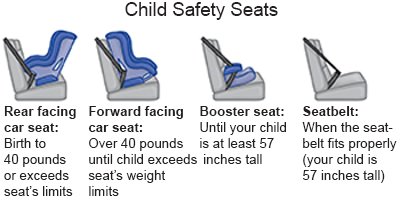
- Always put your child's car seat in the back seat. Never put your child's car seat in the front. This will help prevent him or her from being injured in an accident.
What can I do to make my home safe for my child?
- Place guards over windows on the second floor or higher. This will prevent your child from falling out of the window. Keep furniture away from windows. Use cordless window shades, or get cords that do not have loops. You can also cut the loops. A child's head can fall through a looped cord, and the cord can become wrapped around his or her neck.
- Secure heavy or large items. This includes bookshelves, TVs, dressers, cabinets, and lamps. Make sure these items are held in place or nailed into the wall.
- Keep all medicines, car supplies, lawn supplies, and cleaning supplies out of your child's reach. Keep these items in a locked cabinet or closet. Call Poison Help (1-800-222-1222) if your child eats anything that could be harmful.
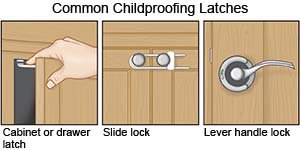
- Keep hot items away from your child. Turn pot handles toward the back on the stove. Keep hot food and liquid out of your child's reach. Do not hold your child while you have a hot item in your hand or are near a lit stove. Do not leave curling irons or similar items on a counter. Your child may grab for the item and burn his or her hand.
- Store and lock all guns and weapons. Make sure all guns are unloaded before you store them. Make sure your child cannot reach or find where weapons or bullets are kept. Never leave a loaded gun unattended.
What can I do to keep my child safe in the sun and near water?
- Always keep your child within reach near water. This includes any time you are near ponds, lakes, pools, the ocean, or the bathtub. Never leave your child alone in the bathtub or sink. A child can drown in less than 1 inch of water.
- Put sunscreen on your child. Ask your healthcare provider which sunscreen is safe for your child. Do not apply sunscreen to your child's eyes, mouth, or hands.
What are other ways I can keep my child safe?
- Follow directions on the medicine label when you give your child medicine. Ask your child's healthcare provider for directions if you do not know how to give the medicine. If your child misses a dose, do not double the next dose. Ask how to make up the missed dose.Do not give aspirin to children younger than 18 years. Your child could develop Reye syndrome if he or she has the flu or a fever and takes aspirin. Reye syndrome can cause life-threatening brain and liver damage. Check your child's medicine labels for aspirin or salicylates.
- Keep plastic bags, latex balloons, and small objects away from your child. This includes marbles or small toys. These items can cause choking or suffocation. Regularly check the floor for these objects.
- Never leave your child alone in a car, house, or yard. Make sure a responsible adult is always with your child. Begin to teach your child how to cross the street safely. Teach your child to stop at the curb, look left, then look right, and left again. Tell your child never to cross the street without an adult.
- Have your child wear a bicycle helmet. Make sure the helmet fits correctly. Do not buy a larger helmet for your child to grow into. Buy a helmet that fits him or her now. Do not use another kind of helmet, such as for sports. Your child needs to wear the helmet every time he or she rides his or her tricycle. He or she also needs it when he or she is a passenger in a child seat on an adult's bicycle. Ask your child's healthcare provider for more information on bicycle helmets.
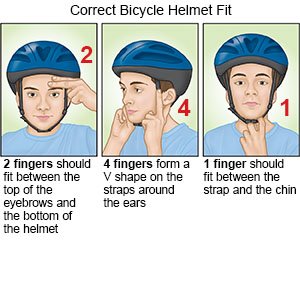
What do I need to know about nutrition for my child?
- Give your child a variety of healthy foods. Healthy foods include fruits, vegetables, lean meats, and whole grains. Cut all foods into small pieces. Ask your healthcare provider how much of each type of food your child needs. The following are examples of healthy foods:
- Whole grains such as bread, hot or cold cereal, and cooked pasta or rice
- Protein from lean meats, chicken, fish, beans, or eggs
- Dairy such as whole milk, cheese, or yogurt
- Vegetables such as carrots, broccoli, or spinach
- Fruits such as strawberries, oranges, apples, or tomatoes

- Make sure your child gets enough calcium. Calcium is needed to build strong bones and teeth. Children need about 2 to 3 servings of dairy each day to get enough calcium. Good sources of calcium are low-fat dairy foods (milk, cheese, and yogurt). A serving of dairy is 8 ounces of milk or yogurt, or 1½ ounces of cheese. Other foods that contain calcium include tofu, kale, spinach, broccoli, almonds, and calcium-fortified orange juice. Ask your child's healthcare provider for more information about the serving sizes of these foods.
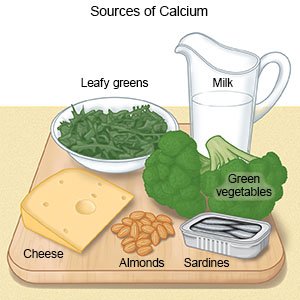
- Limit foods high in fat and sugar. These foods do not have the nutrients your child needs to be healthy. Food high in fat and sugar include snack foods (potato chips, candy, and other sweets), juice, fruit drinks, and soda. If your child eats these foods often, he or she may eat fewer healthy foods during meals. He or she may gain too much weight.
- Do not give your child foods that could cause him or her to choke. Examples include nuts, popcorn, and hard, raw vegetables. Cut round or hard foods into thin slices. Grapes and hotdogs are examples of round foods. Carrots are an example of hard foods.
- Give your child 3 meals and 2 to 3 snacks per day. Cut all food into small pieces. Examples of healthy snacks include applesauce, bananas, crackers, and cheese.
- Have your child eat with other family members. This gives your child the opportunity to watch and learn how others eat.

- Let your child decide how much to eat. Give your child small portions. Let your child have another serving if he or she asks for one. Your child will be very hungry on some days and want to eat more. For example, your child may want to eat more on days when he or she is more active. Your child may also eat more if he or she is going through a growth spurt. There may be days when your child eats less than usual.
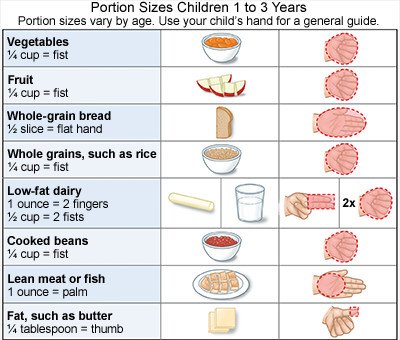
- Know that picky eating is a normal behavior in children under 4 years of age. Your child may like a certain food on one day and then decide he or she does not like it the next day. He or she may eat only 1 or 2 foods for a whole week or longer. Your child may not like mixed foods, or he or she may not want different foods on the plate to touch. These eating habits are all normal. Continue to offer 2 or 3 different foods at each meal, even if your child is going through this phase.
What can I do to keep my child's teeth healthy?
- Your child needs to brush his or her teeth with fluoride toothpaste 2 times each day. He or she also needs to floss 1 time each day. Help your child brush his or her teeth for at least 2 minutes. Apply a small amount of toothpaste the size of a pea on the toothbrush. Make sure your child spits all of the toothpaste out. Your child does not need to rinse his or her mouth with water. The small amount of toothpaste that stays in his or her mouth can help prevent cavities. Help your child brush and floss until he or she gets older and can do it properly.
- Take your child to the dentist regularly. A dentist can make sure your child's teeth and gums are developing properly. Your child may be given a fluoride treatment to prevent cavities. Ask your child's dentist how often he or she needs to visit.
What can I do to create routines for my child?
- Have your child take at least 1 nap each day. Plan the nap early enough in the day so your child is still tired at bedtime. At 3 years, your child might stop needing an afternoon nap.
- Create a bedtime routine. This may include 1 hour of calm and quiet activities before bed. You can read to your child or listen to music. Brush your child's teeth during his or her bedtime routine.
- Plan for family time. Start family traditions such as going for a walk, listening to music, or playing games. Do not watch TV during family time. Have your child play with other family members during family time.
What else can I do to support my child?
- Do not punish your child with hitting, spanking, or yelling. Tell your child "no." Give your child short and simple rules. Do not allow him or her to hit, kick, or bite another person. Put your child in time-out for up to 3 minutes in a safe place. You can distract your child with a new activity when he or she behaves badly. Make sure everyone who cares for your child disciplines him or her the same way.
- Be firm and consistent with tantrums. Temper tantrums are normal at 3 years. Your child may cry, yell, kick, or refuse to do what he or she is told. Stay calm and be firm. Reward your child for good behavior. This will encourage him or her to behave well.
- Read to your child. This will comfort your child and help his or her brain develop. Point to pictures as you read. This will help your child make connections between pictures and words. Have other family members or caregivers read to your child. Read street and store signs when you are out with your child. Have your child say words he or she recognizes, such as "stop."
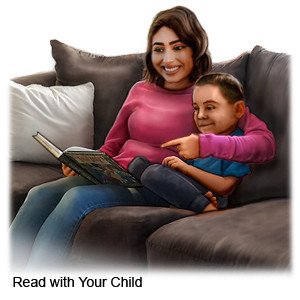
- Play with your child. This will help your child develop social skills, motor skills, and speech.
- Take your child to play groups or activities. Let your child play with other children. This will help him or her grow and develop. Your child will start wanting to play more with other children at 3 years. He or she may also start learning how to take turns.
- Engage with your child if he or she watches TV. Do not let your child watch TV alone, if possible. You or another adult should watch with your child. Talk with your child about what he or she is watching. When TV time is done, try to apply what you and your child saw. For example, if your child saw someone stacking blocks, have your child stack his or her blocks. TV time should never replace active playtime. Turn the TV off when your child plays. Do not let your child watch TV during meals or within 1 hour of bedtime.
- Limit your child's screen time. Screen time is the amount of television, computer, smart phone, and video game time your child has each day. It is important to limit screen time. This helps your child get enough sleep, physical activity, and social interaction each day. Your child's pediatrician can help you create a screen time plan. The daily limit is usually 1 hour for children 2 to 5 years. The daily limit is usually 2 hours for children 6 years or older. You can also set limits on the kinds of devices your child can use, and where he or she can use them. Keep the plan where your child and anyone who takes care of him or her can see it. Create a plan for each child in your family. You can also go to https://www.healthychildren.org/English/media/Pages/default.aspx#planview for more help creating a plan.
- Limit your child's inactivity. During the hours your child is awake, limit inactivity to 1 hour at a time. Encourage your child to ride his or her tricycle, play with a friend, or run around. Plan activities for your family to be active together. Activity will help your child develop muscles and coordination. Activity will also help him or her maintain a healthy weight.
What do I need to know about my child's next well child visit?
Your child's healthcare provider will tell you when to bring him or her in again. The next well child visit is usually at 4 years. Contact your child's healthcare provider if you have questions or concerns about your child's health or care before the next visit. All children aged 3 to 5 years should have at least one vision screening. Your child may need vaccines at the next well child visit. Your provider will tell you which vaccines your child needs and when your child should get them.
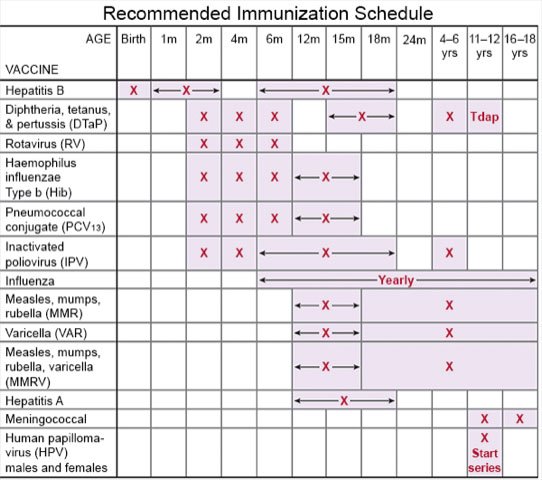 |
Care Agreement
You have the right to help plan your child's care. Learn about your child's health condition and how it may be treated. Discuss treatment options with your child's healthcare providers to decide what care you want for your child. The above information is an educational aid only. It is not intended as medical advice for individual conditions or treatments. Talk to your doctor, nurse or pharmacist before following any medical regimen to see if it is safe and effective for you.© Copyright Merative 2025 Information is for End User's use only and may not be sold, redistributed or otherwise used for commercial purposes.
Learn more about Well Child Visit at 3 Years
Care guides
Further information
Always consult your healthcare provider to ensure the information displayed on this page applies to your personal circumstances.
